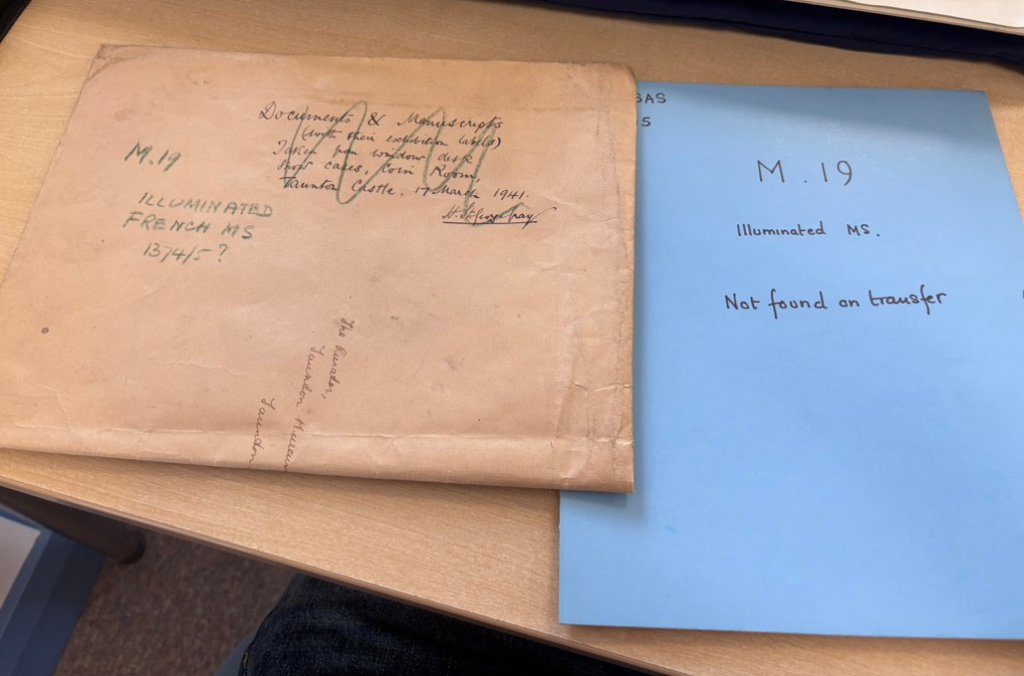
Posted by Thomas Hinton
27 October 2025We have another entry in our ‘Research Postcards’ series this week, courtesy of returning contributor, Thomas Hinton. Fresh from a visit to a local archive, Tom reflects on the ups and downs of following up on research leads, and asks how we might respond when archival research doesn’t necessarily go to plan.
Somerset Heritage Centre is housed in a grey-white cuboid structure with a whiff of leisure centre located in Norton Fitzwarren, on the outskirts of Taunton. I found myself there in September 2025 to follow up a lead on a manuscript of potential relevance to the Learning Anglo-French project. As part of our work on the project, we had identified an entry in the Somerset Archive Catalogue relating to an ‘Illuminated French MS. 1374/5?’. The mention of French, along with ‘English-style illustration’ in the description, strongly suggested that we might be dealing with a late fourteenth-century Anglo-French production. Whether of direct relevance to the project’s focus on language teaching or not, this clearly merited investigation, and a half-day trip up the M5 was duly arranged.
Upon arrival at the Centre, I left my bag in a locker and proceeded through to a well-lit reading room with a studious but welcoming atmosphere. A few minutes later, I was in possession of a large bundle of miscellaneous documents (shelfmark DD/SAS/C795/M), within which my manuscript was apparently located. As I sifted through, I began to feel a wave of disappointment pass over me – nothing in this pile had the form of a whole manuscript. But perhaps the entry was referring to a humble fragment? Eventually I found the relevant document listed as M19 – a large piece of blue card bearing the inscription: ‘Illuminated MS. Not found on transfer.’ Next to it was a manila envelope addressed in 1941 to ‘The Curator, Taunton Museum’, on which someone had scribbled in dark-green pencil: ‘M19. Illuminated French MS. 1374/5?’. The envelope was empty.


With a nasty feeling growing in the pit of my stomach, I headed to the issue desk to seek confirmation of the disappointment I was now primed for. I was directed to a highly helpful archivist, who listened to my story before heading backstage to make enquiries. Returning around ten minutes later, she explained apologetically that the manuscript was missing, and that the ‘transfer’ in question at which its absence was noted had taken place in the 1950s. The chances of finding it again in the current collection, amidst the vast numbers of documents that the team has in its care, were therefore negligible.
Beyond the loss of a promising lead (a blow that was partially softened by the discovery of Dough, a delightful café in Taunton town centre), this research trip confirmed an important truth of archival work: disappointment is part and parcel of the process. By its nature, speculative investigation will most often uncover the square root of nothing at all, and one must steel oneself for this every time one heads into the fray. On my way back down towards Junction 29 of the M5, I consoled myself with the thought that dead ends like this one are what make the occasional successes so exciting. Alongside which, I could still point to a clutch of positive outcomes: correction of a misleading catalogue entry; familiarisation with a previously unknown repository; a tantalising glimpse into the frailties and contingencies of archival history; and a decent story to relate on a CMS Research Postcard.
Header image: the façade of Somerset Heritage Centre. Photo credit: Somerset Archives and Local Studies.